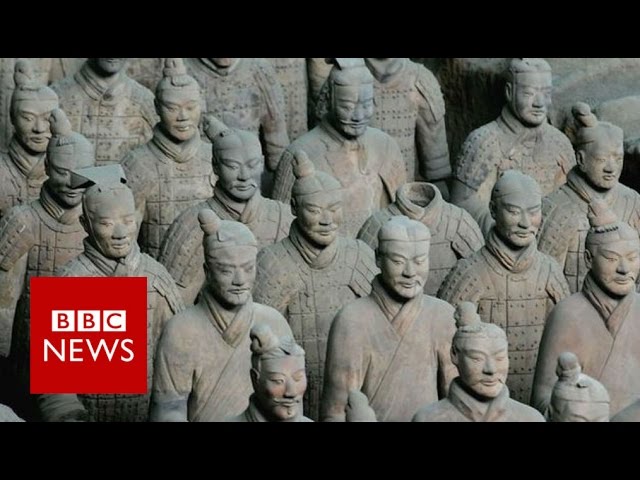The Terracotta Army is a collection of terracotta sculptures depicting the armies of Qin Shi Huang, the first Emperor of China. It is a form of funerary art buried with the emperor in 210–209 BCE and whose purpose was to protect the emperor in his afterlife. The figures, dating from approximately the late third century BCE, were discovered in 1974 by local farmers in Lintong County, Shaanxi, China. The figures vary in height according to their roles, with the tallest being the generals. The figures include warriors, chariots, horses, officials, acrobats, strongmen, and musicians. Current estimates are that in the three pits containing the Terracotta Army there were over 8,000 soldiers, 130 chariots with 520 horses and 150 cavalry horses, the majority of which are still buried in the pits.
History
The Terracotta Army was assembled for the funeral of Qin Shi Huang, the first Emperor of China. He was buried in 210–209 BCE with the army to protect him in his afterlife. The sculptures vary in height according to their roles, with the tallest being the generals. The figures include warriors, chariots, horses, officials, acrobats, strongmen, and musicians. The figures were manufactured in workshops by government laborers and local craftsmen using local materials. The head and upper body were made from molded clay, with the lower body made from strips of clay. The faces were created with molds, and then each face was unique and carefully detailed.
Discovery and Excavation
The Terracotta Army was discovered in 1974 by local farmers in Lintong County, Shaanxi, China. The farmers had been digging a water well and stumbled upon a large pit filled with terracotta figures. The discovery sparked a massive excavation effort by Chinese archeologists and the first emperor’s tomb was found in 1976. To date, three pits have been excavated and it is estimated that in these three pits there were over 8,000 soldiers, 130 chariots with 520 horses and 150 cavalry horses, the majority of which are still buried in the pits.
Preservation and Conservation
The Terracotta Army is one of the most significant archaeological finds of the 20th century and is considered a national treasure in China. The figures are fragile and have been exposed to the elements for over 2,000 years. As such, preservation and conservation of the figures is a priority for Chinese archeologists. To preserve the figures, a protective shelter was built over the excavation site and the figures are now displayed in a museum. In addition, restoration and conservation work is ongoing to repair and stabilize the figures.
Cultural Significance
The Terracotta Army has become a symbol of the power and wealth of the first emperor of China and is an important part of Chinese culture. The figures have been featured in books, movies, and video games, and they have become a popular tourist attraction in China. The figures are also a source of inspiration for Chinese artists and have been used in many works of art.
Conclusion
The Terracotta Army is an incredible archaeological discovery and a significant part of Chinese culture. The figures provide an insight into the life of the first emperor of China and have become a symbol of his power and wealth. The figures are fragile and have been exposed to the elements for over 2,000 years, so preservation and conservation of the figures is an important priority. The figures have become a popular tourist attraction in China and a source of inspiration for Chinese artists.


0 Comments